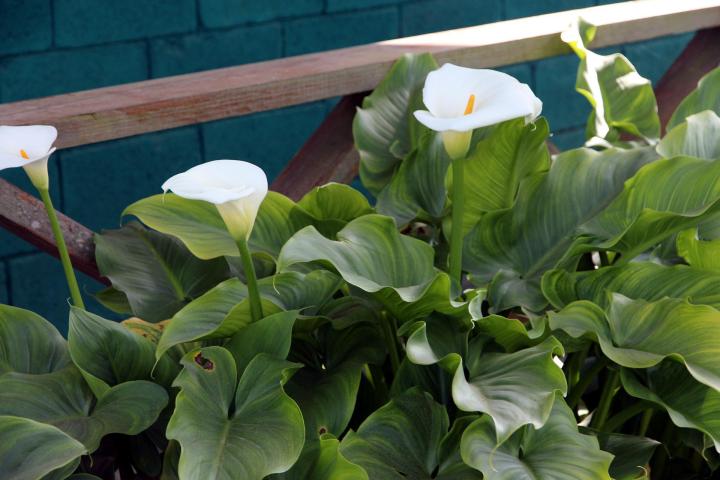The heart is essential to physical life, and it is also a definition of moral vigor. Pope Pius XII once said, “The heart is the noblest part of human nature.”
We can all recall some of the familiar idioms about the heart: big hearted, a song in one’s heart, broken hearted. Each indicates the nature of a person.
The devotion to the Sacred Heart of Jesus reminds us of this twofold aspect: His heart of flesh and the spiritual essence that gives rise to virtue. The devotion of Jesus’ love for us enlivens our devotion of love for Him; this is the crux of the Devotion to the Sacred Heart.
To be a Christian is to live and share the faith. The symbolism of plants in Christian art and legend lends itself well to creating gardens of visible prayer and devotion, and is a means to share our faith with those who enter our gardens.
There are dozens of plants suitable for a garden dedicated to The Sacred Heart of Jesus. Here are just a few, with culture information included.
A tip: When planning a garden it is best to start with the more permanent hardwood plants, a tree or shrub. It is around these plants that seating for shade is established, and the placement of herbaceous plants is determined.
Juniper
The diversity of a shrubby Juniper, Juniperis spp., lends itself well to any spiritual garden. The juniper is mentioned by name in the Bible, with a strong identity in art history and legend. In Isaiah 60:13, it is included as one of the three sanctuary trees. It is also used as an aspergillum, an implement for sprinkling holy water.
Juniper is a diverse evergreen with hundreds of cultivars to choose from. It can withstand bitterly cold or hot and dry weather and is salt tolerant, making it an excellent plant for seashores and alongside walks and drives. It blooms in late winter, and is a source of pollen for bees when few other plants are available for food.
Juniper is symbolic of Christ’s Passion, eternity (since its wood is decay resistant), and strength and glory.
Hardy in Zone 3-9 (cultivar specific), junipers require full sun to light shade; watering is average to light. Average well drained soil, being tolerant of most soil conditions except excessively dry or wet.
Periwinkle
In a shaded area grow Periwinkle, Vinca minor cvs. This evergreen ground cover has a long association with the holy, most strongly when it comes to memento mori, remembering death. In many cultures the Vinca species represented a binding love, especially an existence of such love throughout eternity. This association comes from the vine being long lived and able to secure the earth beneath it, as love secures us in this realm.
A spreading ground covering vine — and in some regions considered weedy — it is hardy in Zones 3-8. It will tolerate part sun in the morning, though preferring full shade. Once established watering is low, but it grows best in evenly moist, organically rich to average well drained soil. It is tolerant of dry, shallow, and rocky soils, where its size will be diminished.
Tulip
Within the periwinkle or elsewhere in your garden plant the Tulip, Tulipa spp. In all its diversity, the tulip is symbolic of divine or perfect love — as the Devotion to the Sacred Heart recalls — and the brevity of life. The tulip’s petals reopen when light comes, which signifies the soul’s opening to the Light of God.
Many tulips are hardy in Zones 4-6, requiring at least five hours of direct sunlight. They do best with morning sun and light afternoon shade. Needing average watering and a cool moist winter, tulips require organically rich and well drained soil, though they do grow well in soils with nutrient rich clay.
Calla Lilly
For a garden that remains moist the Calla Lily, Zantedeschia spp., can be considered. The symbolism of the calla lily points towards Easter and the Resurrection, representing rebirth.
Some consider this flower, in the shape of a trumpet, to herald Jesus’ victory over death. The flower’s prominent symbolism of new birth, hope, and promise are all part of our faith, for through Jesus’ Sacred Heart we are assured of life after death.
Calla lilies are hardy in Zones 8-10, requiring full sun and afternoon shade in hotter climates. Its water needs are high and specific: medium to wet environments where there is no standing water. The soil needs to be rich, cool, evenly moist, and well drained. These plants love to grow next to a pond or at the edge of bog or rain gardens.
Maltese Cross
‘A consuming fire burning with love and devotion by both the lover and the beloved’ — what amazing symbolism for the flame-red flower of the Jerusalem or Maltese Cross, Silene chalcedonica.
The Passion and love of Jesus, the love and courage of Mary, the wisdom of the Holy Spirit in us to continue God’s mission on earth — all this can be contemplated through these blooms.
The five-petal blossom is shaped like a star and is compared to God’s burning love shining down on his people, a light through our journey. It was the four-petal flowers that inspired the Maltese Cross, which is now a common symbol of firefighters.
Hardy in Zones 3-8, it needs full sun and will tolerate light afternoon shade. This plant requires average watering in evenly moist well drained soils. Its deep tap root allows for being somewhat drought tolerant.
Other beautiful plants …
Other plants with familiar symbolism suitable for this type of garden are Grapes (Vitis spp.),Bleeding Heart (Lamprocapnos spectabilis), Carnation(Dianthus spp.), Anemone (Anemone coronaria), and Poppy (Papaver spp.).
All plants descriptions presented here are excerpts from Margaret Rose Realy’s upcoming book A Garden Catechism; 100 Plants in the Christian Tradition and How to Grow Them, releasing in 2022 through Our Sunday Visitor.









